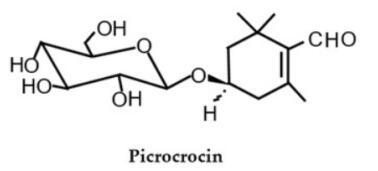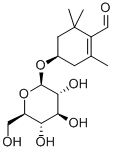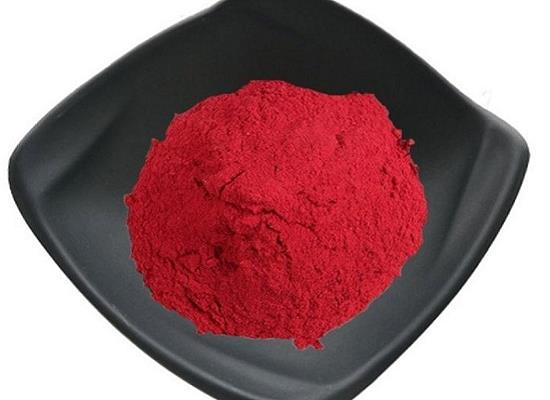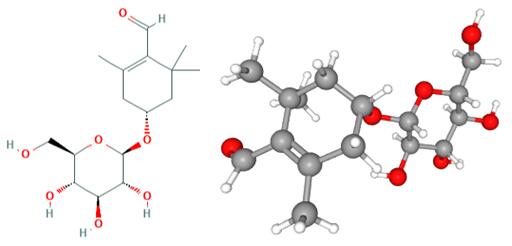What is Picrocrocin?
Picrocrocin ((4S)-2,6,6-trimethyl-4-[(2R,3R,4S,5S,6R)-3,4,5-trihydroxy-6- (hydroxymethyl)oxan- 2-yl]oxy-cyclohexene-1-carbaldehyde; (R)-4-(β-D-glucopyranosiloxy)- 2,6,6-trimethyl-1- cyclohexene-1-carbaldehyde; (R)-4-(β-D-Glucopyranosyloxy)-2,6,6-trimethyl -1-cyclohexene-1- carbaldehyde; Saffron-bitter; Picrocrocine; 1-Cyclohexene-1-carboxaldehyde,4- (b-D-glucopyranosyloxy)-2,6,6-trimethyl-,(4R)-; Safranbitter; C16H26O7 ) [1], composing of safranal and glycoside, is one major compounds of saffron (Crocus sativus L. stigma), responsible for the bitter taste of saffron and a molecular marker of this spice, whose taste cannot be imitated from other spices or seasonings, and it can serve to identify true saffron [2]. Saffron possesses various therapeutic activities such as antihypertensive, anticonvulsant, antitussive, antigenototoxic, anticancer, cytotoxic effects, anxiolytic, antioxidant, antidepressant, anti-inflammatory, and relaxant activity. As major bioactive compounds of saffron, picrocrocin also has some valuable medicinal properties similar as saffron, especially anticancer effect.

Picrocrocin as component of saffron displays same antitumor activity that have great potential for the prevention and treatment of various cancers through affecting cellular DNA and RNA synthesis and free radical scavenging activities of cancer [3]. The experiments results for studying the effect of picrocrocin on proliferation of human tumoral cells (HeLa cell) in vitro showed that picrocrocin have a dose dependent inhibition of cell growth, and doses of picrocrocin inducing 50% inhibition of HeLa cell growth are 3 mM, in which picrocrocin have minor cytotoxicity for normal cells[4]. Thus, picrocrocin can inhibit the growth of cancer cell. Other study results have showed that picrocrocin with highly bioaccessible could be transported quickly and reduced the proliferation of human adenocarcinoma and hepatocarcinoma cells [5]. However, the further study indicated that picrocrocin has not antioxidant properties and do not protect against oxidant-induced DNA damage in U937. Xiao groups research showed that picrocrocin exhibits growth inhibitory effects against SK-MEL-2 human malignant melanoma cells by affecting mitochondrial mediated apoptosis and cell cycle arrest. Meanwhile, picrocrocin enhanced the reactive oxygen species levels, decreased the mitochondrial membrane potential levels of SK-MEL-2 cells, and further inhibited the JAK/STAT5 signalling pathway in the SK-MEL-2 melanoma cells [6]. On rat mammary tumor induced by N-methyl-N-nitrosourea, after treated with picrocrocin, EDA activity increased obviously in the cancerous groups and tumor size decreased in cancerous group, suggesting the beneficial effect of picrocrocin in breast cancer treatment [7]. In addition, by digestive enzymes or microbiota metabolism in vivo, picrocrocin would be conversion to safranal and enhanced it bioavailability.
All these study results could indicate that picrocrocin with anticancer properties have great potential application in medicine usage for prevention and treatment of human tumors. However, as one of three major bioactive components of saffron, compared with crocin and safranal, the other medicinal value of picrocrocin such as anti-microbial, carminative, sedative, emmenagogue and so on, deserved to further research.
References
[1] https://www.chemicalbook.com/ProductChemicalPropertiesCB51236201.htm.
[2] Rahaiee, S., Moini, S., Hashemi, M., & Shojaosadati, S. A. (2015). Evaluation of antioxidant activities of bioactive compounds and various extracts obtained from saffron (Crocus sativus L.): a review. Journal of food science and technology, 52(4), 1881-1888.
[3] Shahi, T., Assadpour, E., & Jafari, S. M. (2016). Main chemical compounds and pharmacological activities of stigmas and tepals of ‘red gold’; saffron. Trends in food science & technology, 58, 69-78.
[4] Escribano, J., Alonso, G. L., Coca-Prados, M., & Fernández, J. A. (1996). Crocin, safranal and picrocrocin from saffron (Crocus sativus L.) inhibit the growth of human cancer cells in vitro. Cancer letters, 100(1-2), 23-30.
[5] Kyriakoudi, A., O’Callaghan, Y. C., Galvin, K., Tsimidou, M. Z., & O’Brien, N. M. (2015). Cellular transport and bioactivity of a major saffron apocarotenoid, picrocrocin (4-(β-D-glucopyranosyloxy)-2, 6, 6-trimethyl-1-cyclohexene-1-carboxaldehyde). Journal of agricultural and food chemistry, 63(39), 8662-8668.
);



